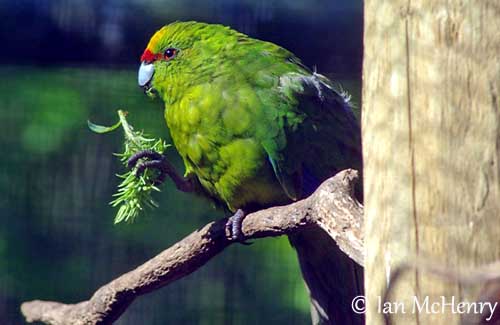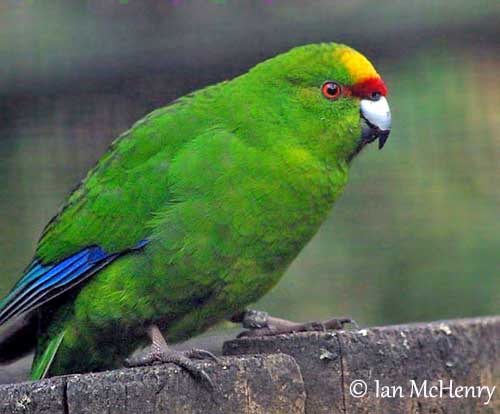
Fr: Perruche à tête d’or
Ang: Yellow-fronted Parakeet – Yellow-crowned Parakeet
Maori: Kakariki
All: Springsittich
Esp: Perico Maorí Cabecigualdo
Ita: Kakariki frontegialla
Nd: Geelvoorhoofdkarakiri
Sd: Gulpannad parakit
Photographer:
Ian McHenry
My New Zealand Birds
Text by Nicole Bouglouan
Sources:
HANDBOOK OF THE BIRDS OF THE WORLD vol 4 by Josep del Hoyo-Andrew Elliott-Jordi Sargatal - Lynx Edicions - ISBN: 8487334229
PARROTS OF THE WORLD – An Identification Guide – by Joseph M. Forshaw – Princeton University Press – ISBN 0691092516
KNOW YOUR NEW ZEALAND BIRDS by Lynnette Moon - New Holland Publishers – ISBN: 1869660897
BirdLife International (BirdLife International)
New Zealand bird status between 2008 and 2012
New Zealand birds and birding (Narena Olliver)
Wikipedia, the free encyclopaedia
Yellow-fronted Parakeet or Yellow-crowned Parakeet
Cyanoramphus auriceps
Psittaciformes Order – Psittaculidae Family
INTRODUCTION:
The Yellow-fronted Parakeet is endemic to New Zealand area including several offshore islands. This species is uncommon due to predation by introduced mammals and habitat destruction by humans. It frequents the beech forests and usually occurs in upper canopy of tall trees.
Its Maori name is “Kakariki”.

DESCRIPTION OF THE BIRD:
Biometrics:
Length: 23-25 cm
Weight: M: 50g – F: 40 g
The adult has bright green plumage overall. There is a crimson-red patch on each side of the rump. On the upperwing, the outer webs of the flight feathers are blue. The green tail is long and graduated.
On the underparts, rectrices and flight feathers are brownish.
On the green head, we can see a bright red frontal band extending from eye to eye. The crown is golden yellow.
The bill is silvery-grey with black tip and cutting edge. The eyes are red-orange. Legs and feet are greyish-brown.
Both adults have similar plumage, but the female is slightly smaller than male.
The juvenile resembles adult, but it has shorter tail and pale brown eyes.
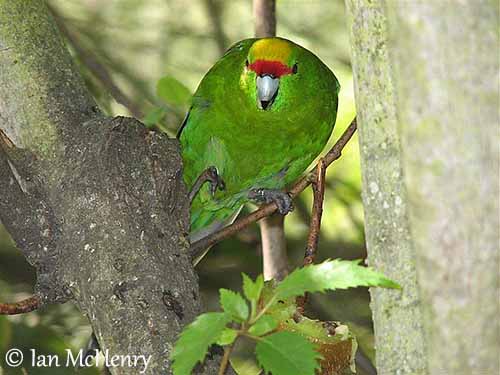
RANGE:
The Yellow-fronted Parakeet occurs in New Zealand, including North I, South I, Stewart I, Auckland Is and several offshore islands.
HABITAT:
The Yellow-fronted Parakeet is still present in most large native forest, and it is mostly confined to tall forests on the mainland. On smaller islands, it can be common in low scrub or sometimes in open grassland.
It is usually found at higher elevation than the Red-crowned Parakeet.
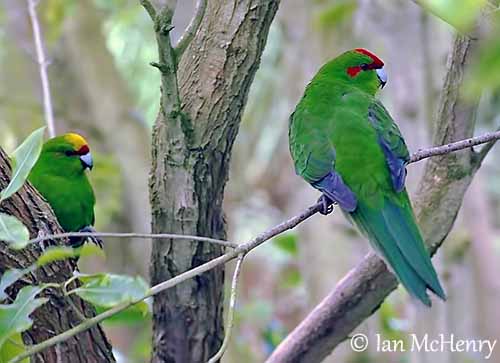
On the right
CALLS AND SONGS: SOUNDS BY XENO-CANTO
The Yellow-fronted Parakeet utters a typical chatter in flight, a repetitive, high-pitched “ki-ki-ki-ki” given by both sexes. Other quieter, less distinctive calls can be heard too.
BEHAVIOUR IN THE WILD:
The Yellow-fronted Parakeet feeds on seeds, buds, shoots, flowers, leaves, fruits and invertebrates such as caterpillars and insects.
It forages high in the upper canopy of tall trees, and rarely on the ground for fallen fruits or seeds. However, on predator-free islands, it feeds often on the ground.
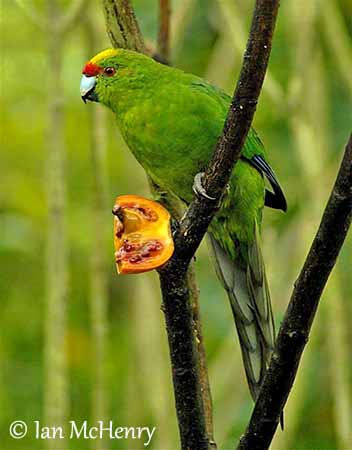
During the breeding season, the nesting territory is aggressively defended against other pairs. The breeding season is closely related to beech cycles, and may last longer time when food resources are abundant.
They are cavity-nesters and usually nest in natural cavities, often holes in trees.
It is often seen alone or in pairs, but feeding flocks are observed in autumn and winter.
The Yellow-fronted Parakeet is sedentary in its range.
It performs swift, slightly undulating flight with shallow wingbeats interspersed with glides.
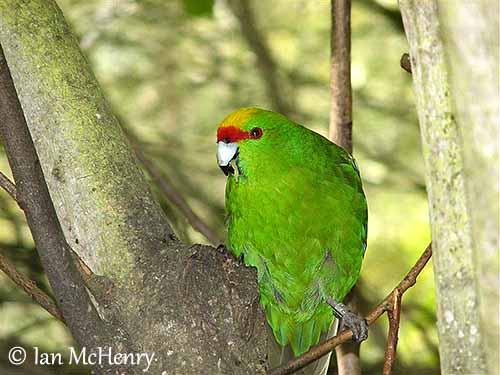
REPRODUCTION OF THIS SPECIES:
The breeding season occurs mainly between October and December, but when the food resources are abundant, this species can breed throughout the year, producing several broods.
The Yellow-fronted Parakeet nests in tree holes, often in tall trees up to 30-32 metres above the ground.
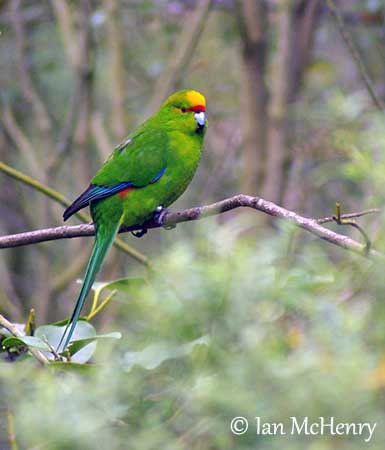
The female lays 2-9 white eggs onto a lining of rotten wood at the bottom of the cavity. She incubates alone during about 3 weeks. She is fed by the male, by regurgitation outside the nest during this period.
The chicks are fed by the female with the food regurgitated by the male. They fledge 37-45 days after hatching.
The chicks are vulnerable to predation by introduced mammal predators which take them in the nest cavity.
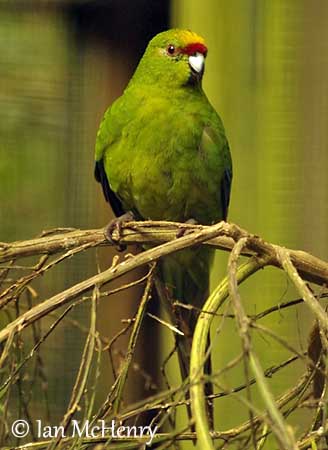
PROTECTION / THREATS / STATUS:
The Yellow-fronted Parakeet is the prey of stoats, rats and possums while nesting and roosting in holes.
The species is more abundant on predator-free islands, and has been successfully introduced to 3 islands, Mana, Long Island and Motuara. Other translocations are underway.
Declines due to deforestation and modification of the habitats by humans have been reported throughout the range. Predators and hybridization also affect the numbers (10,000/19,999 mature individuals).
The Yellow-fronted Parakeet is currently listed as Near Threatened.
